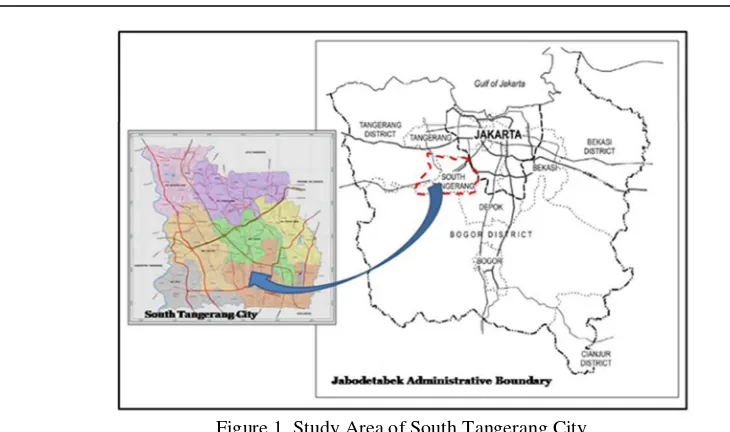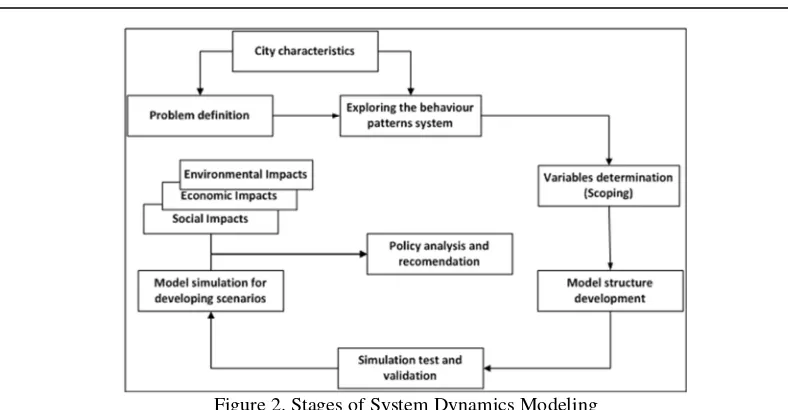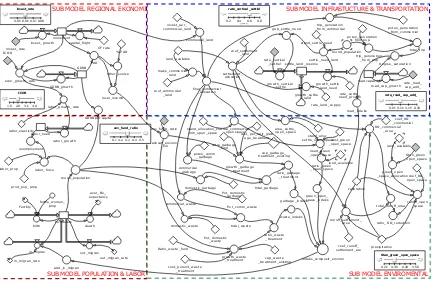Model Designing for Sustainable New City Development: A Case
Study for South Tangerang City, Indonesia
Heri Apriyanto1,3* Eriyatno2 Ernan Rustiadi2 Ikhwanuddin Mawardy3
1.Doctoral Program Student of Natural Resources and Environment Management Program, Graduate School, Bogor Agricultural University, IPB Campus Baranangsiang, Bogor, Indonesia
2.Graduate School, Bogor Agricultural University, IPB Campus Baranangsiang, Bogor, Indonesia 3.National Agency for Assessment and Application of Technology (BPPT), Jakarta, Indonesia
* E-mail of the corresponding author: [email protected]
Abstract
Development of new city is expected to solve such problems as population pressure reduction in large cities, regional economic development, etc., but the reality does not correspond to the objectives. The development of a new city has brought convenience to the people's production and life. However, at the same time, with the increasing of urban factor intensity, the problems such as the traffic, security, infrastructure, and environment and others are growing. A case study of the research was conducted in the South Tangerang City, Banten Province, Indonesia. The development of this city had only focused on economic aspect, other aspects such as environmental (especially on environmental carrying capacity) and social aspect should be paid sufficient attention. Therefore, in city development control should be implemented in ensuring sustainable cities development. Assessment on sustainable cities development is systematically, because city growth is affected by behavior of elements such as economic, ecology and social elements which constructed a city. The aim of research was to design a model designing for sustainable development of South Tangerang City. System dynamics approach was employed to develop the model. The model contain of some sub model, i.e.: Population and Labor, Regional Economic, Environmental Condition, and Infrastructure and Transportation sub model. Some scenario were determined and simulated to predict economic, social and environmental impact. Recommended policies to achieve its sustainability i.e. increasing investment, green open space, vertical settlement, road capacity, and budget for the environmental sector.
Keywords: Sustainable New City Development, System Dynamics, South Tangerang City, scenario
1. Introduction
Over 50% of the world’s population lives in cities, and although covering only 3% of the world’s land mass, they consume 75% of the world’s resources and emit a corresponding proportion of greenhouse gas emissions
(Seymoar et al. 2009). During the past decades, urban residential development has speed up extremely with
massive population mobility in cities. In 2009, the United Nations estimated that the world’s population is projected to reach 7 billion in late 2011, up from the current 6.8 billion, and surpass 9 billion people by 2050 (United Nations, 2009).
Urban residential areas, facing restriction by social-economic level, environmental pressure, population pressure and traffic pressure, etc, attract growing attentions nowadays as an important component of sustainability study. Sustainability is a multi-dimensional concept that takes into account different elements of territorial development, such as economic growth, well-being of population, environmental quality, etc. (Bruntland 1987).
Jakarta, the capital of Indonesia, expanded from 180 km2 in 1960 to a fully urbanized metropolis in the
1970s. Today, as a mega-city, Jakarta’s nucleus area has spatially and economically expanded beyond its original fringes. Jakarta has increasingly been integrated with eight other proximate cities, and called as
Jabodetabek Metropolitan area. Now, Jabodetabek encompasses a total land of 6,580 km2, with Jakarta area is
656 km2 and 9.6 million inhabitants (Hasibuan et al. 2014). Jabodetabek is composed of 9 independent
municipalities; Jakarta, Bogor (Regency/City), Tangerang (Regency/City), Bekasi (Regency/City), Depok (City) and South Tangerang (City) with 21 million inhabitants.
In essence, the city is a socio-economic entity of high concentration of the production and living factors composed of the mutual integration of the natural, artificial, and socio-economic environment. This determines the survival and development of the city is bound to consume a large amount of material and natural resources. Meanwhile, in this process, it will also produce a lot of wastes, which causes a devastating effect on
the natural environment, eventually leading to the unsustainable development of the city (Dou et al. 2013).
Sustainable city development is systemic phenomena, which growth of a city was generated by behavior of each element such as economic, ecology and social. The aim of the paper was to design a model which employed to simulate sustainable aspects of the South Tangerang City development using System Dynamics approach.
2. Sustainable Cities dan System Dynamics Approach
System dynamics is a technique which uses qualitative and quantitaive models in order to explain systems and determines the type of the feedback of information which forms the behavior and the structure of the feedback and control policy (Coyle 1998). A system dynamics model is composed of many variables. These variables simplify complex phenomena and provide a description of a system’s current state or problems. Basic variables that describe the real-world urban development can be established from the elements that make up a city’s different dimensions such as industry product, population growth and vacancy rate. The urban development framework takes a system-based approach by systemizing the city’s internal elements. The systemic variables then provide not only a clear reflection of the interactions between all of the sub-systems but also how they relate to the overall system (Ho & Wang 2008).
System Dynamics is a realistic tool for sustainability assessment, utilized to better understand the sustainable development in a considered period and forecast the future trends (Xu 2011). System dynamics has the characteristics of stating the relations that form systems, by the help of based figures, graphs and mathematical methods. Therefore managers, governors, economists, population experts and other many concerns
may solve the problems they face by this approach (Soyler et.al. 2008).
The city is a regional and geographical community composed of the mutual integration of the natural, artificial, and socio-economic environment, and its basic characteristics are the high density of the population, materials and capitals, space, and activities. From the aspect of system theory to view, the city is a complex great system composed of the subsystem such as the natural, economic, social, construction system and so on. In this complex great system, the natural system including the natural conditions, the natural resources and the natural environment is a basis, and the change and development of the economic, social, and building system is built on the basis of natural system. Obviously, if the city's natural system is out of b balance or has been seriously
damaged, then the development of the city as a whole will be difficult to sustain (Dou et al. 2013).
Sustainable city is concept that has been paid attention since 1990’s. The concept is reflection notion that sustainable economic development can only be achieved through effort begun at the local level. In recent years, environmental issues associated with rapid economic development are becoming critical concerns suffered by the national and local governments. Environmental issues associated with rapid economic development are
becoming critical concerns that arouse government’s and people’s particular attention (Guan et al. 2011).
Sustainability refers to maintaining the existence of the ecosystem and its services, while also providing for human needs, whereas, in contrast, urban development refers to any activity that improves the quality of life by depleting natural resources and devastating natural areas. Sustainability assessment helps policy-makers decide what actions they should and should not take to make our cities more sustainable
(Yigitcanlar et al. 2014).The system dynamics method is used in research to assess the impacts of four typical
kinds of urbanization policies on land use changes in China. Five subsystems were identified and each subsystem interacted among them. The five subsystem were urbanization subsystem, social subsystem, landuse subsystem,
environmental subsystem and economic subsystem (Wu et al. 2011).
3. Methodology
3.1 Profile of the Study Area
South Tangerang City was established formally in 2008. The city is part of Banten Province which located in
peripheral area of Jakarta (see Figure 1). Area of the city is 147,19 km2 with number of populations are
approximately 1.355.926 peoples, therefore average density of population was 9.544 inhabitants per km2 (in
Figure 1. Study Area of South Tangerang City
Planning area is largely idle land in the 1990s. The land is dominated by land use for farms. Land use changes phenomena from non-built up area into built up area has been in the South Tangerang City. Land use changes from farmland into human settlement, industrial and commercial/service area has been occured fast. Built up area to about 79% of the total area in 2012. Thus the development of the South Tangerang city can not be based on land resources, but more oriented towards other sectors, such as services and trade industries.
3.2 Method
System dynamics was employed to develop model of sustainable South Tangerang City Development. System dynamics is a discipline to research system dynamics complexity. It takes the method, which combine qualitative and quantitative research as well as the system synthesis reasoning, to make the analysis of various factors of a feedback loop between cause and effect, from the complex phenomenon in analysis of the phenomenon of the
internal causes and its formation mechanism (Lei et al. 2012). There are four elements defined in an system
dynamics, including state variables (stock), flow function (flow), auxiliary variables (convertor), and streamline
(connector), with decision-making feedback loops (Wu et al. 2011).
System dynamics discipline has beeen used for a long time in various areas in order to build quantitative models for strategic problems. The aim is to determine appropriate policies to monitor the behavior of the system model and develop the system (Coyle 1998).The stages of the sustainable new city development system dynamics approach are (see Figure 2):
• Problem definition
• Exploring the behavior patterns system (telling the stories, narrative explanation) of regional
development through statistical data exploration and institutional survey.
• Variables Determination (Scoping)
• Model variables determination particularly depend on the objective of model development. Activities
to obtain these variables consist of discussion with experts.
• Model structure development consist of causal loop and systems dynamics diagrams development
activities. Model structure will develop through review of developed model.
• Simulation test and validation
- Logical test of Causal Loop
- Structural test of systems dynamics diagrams - Logical test of simulation result
- Compare the result of simulation test with historical data
• Model simulation for developing scenarios of South Tangerang City
Models which have been develop will used to simulate of development scenarios.
Figure 2. Stages of System Dynamics Modeling
3. Modeling and Simulation
The first stage in constructing an system dynamics model is to define the system boundary (Wu et al. 2011). In
preliminary model, the system model of sustainable South Tangerang City development will be bounded as single city, therefore impact from other areas were be described in very little portion. The objective of the model was prediction sustainability of the city, therefore model will simulate three aspect of sustainability, i.e.: Gross Domestic Regional Product (GDRB) as representation of economic aspect, unemployment (social aspect) and environmental index which aggregate index of waste, garbage, greeen open space and traffic jump potential (environmental aspect). Scopes of model development can be summarized in the Table 1.
Table 1. Scopes of model for sustainable new city development
Sub model Sector
Regional economic GDRB per capita
Investment Economic growth
The income of local or PAD ICOR
Budget allocation
Social City population
Population growth Labor
Environmental Solid waste (garbage)
Waste
Water availability Flood (runoff) Green open space
Infrastructure and
Transportation
Settlement Transportation
Figure 3. Causal Loop of Sustainable City System
Qualitative model of system should be converted into quantitative model for supporting simuation of sustainability. In system dynamics method, quantitative model called stock-flow diagram. Stock-flow diagram consist of state variables (stock), flow function (flow), auxiliary variables (convertor), and streamline (connector), with decision-making feedback loops. Stock-flow diagram was show as follow (see Figure 4).
Figure 4. Stock-Flow Diagram of Sustainable South Tangerang City
By employingstock flow diagram which have been developing, we simulated some sustainability aspect of South Tangerang City development from 2010 – 2030. Four variables were simulated in representing of sustainable aspect. The four variables were GDRB per capita, economic growth rate, degree of saturation (road), and garbage and treatment capacity. Four variables, i.e.: rate of investment,Incremental Capital Output Ratio (ICOR), fund for environment management were selected in determining some scenarios for simulation purpose.
This study used two scenarios, ie.:
Investment
Inftrastructure & Transportation Sub Model Regional Economic Sub Model
SUB MODEL POPULATION & LABOR SUB MODEL ENVIROMENTAL
SUB MODEL INFRASTUCTURE & TRANSPORTATION
Simulation results were show in Figure 5.
Figure 5. Simulation Result of Sustainable South Tangerang City Development
Simulation result show as follow :
1) Simulation under BAU scenario show development of South Tangerang toward into not-sustainable level
of development. Simulation of GDRP per capita lean to decline, because of growth of population is not supported by economic growth significantly. Economic growth move slowly, and also investment grow under their expectation, because ICOR was not change which show there was no improvement in regional efiecency (recent ICOR of Sout Tangerang is 2.48).
Also, transportation sector performance wasquite low, indicated by increasing of saturation level of road. Increasing of the one indicate road trasnportation service lowly. The situation was caused by un-balancing between trip generation and increasing of road capacity.
Production of waste both industry and domestic waste, pollute potentially to the city, because of un-balancing between waste production and increasing of waste management facilities. Lack of waste management facilities cause increasing volume of of un-transported waste, therefore incresaing of unplanned garbage dumps.
2) Simulation under policy intervention scenario, predict better economic development, which is indicated
increasing of economic growth significantly. In end of simulation years (2030), economic growth is predicted by 9 % per year, also GDRB per capita simulated tend to increase fastly.
Some development indicators are predicted to improving significantly. In, transportation sector, decreasing of road saturation level was predicted, which indicate improvement in road transportation service. The improvement would support to economic and other activities.
Waste management was predicted better, due to increasing budget allocation for the management. Improvement in some indicators suach as waste management, reducing traffic jumps, and increasing of open space availability would create level of confortable of the city.
Based the simulation, scenario of policy intervension was appropriate scenario should be implemented in ensuring sustainable new town development. By implementation the scenario, development of South Tangerang was expected to be sustain in term increasing income both regional and people income and increasing community perticipation in maintaining of sustainable environment of their city.
5. Conclusion
The sustainable development system approach consider the balance among the goal of economic improvement, the social-cultural stability of the local people, and everlasting environment. This is reflected with the model had prepared. The system dynamics model of Sustainable South Tangerang City development consists of sub models: population and labor; regional economic, environmental condition, and infrastructure and transportation performance.
2010 2015 2020 2025 2030
G
business as usual scenario
policy intervention scenario
2010 2015 2020 2025 2030
G
GARBAGE AND TREATMENT CAPACITY RATIO
business as usual scenario
2010 2015 2020 2025 2030
Ec
business as usual scenario
policy intervention scenario
2010 2015 2020 2025 2030
d
DEGREE of SATURATION (road)
business as usual scenario
Simulation by employed two scenarios, i.e.: BAU and Policy Intervention scenarios, were predicted deference result significantly. BAU scenario prediction produced worse conditions than policy intervention scenario in term people income, road transportation service, waste management and comfortable level of the city.
It was recommended to develop more accurate model which consider some aspects such as criminality level, human quality, and land use change.
References
BPS. (2013), “Kota Tangerang Selatan dalam Angka 2012”, BPS Kota Tangerang Selatan, Indonesia. Bruntland, G. (1987), “Our Common Future”. Oxford: Oxford University Press.
Coyle, G. (1998). “The Practise Of System Dynamics: Milestones, Lessons and Ideas From 30 Years
Experience”, System Dynamics Review 14, 343- 366.
Dou, X., Li, S., & Wang, J. (2013), “Ecological Strategy of City Sustainable Development”, APCBEE Procedia
5, 429 – 434.
Guan, D., Gao, W., Su, W., Li, H., & Hokao, K. (2011), “Modeling and Dynamics Assessment of Urban Economy–Resource–Environment System with a Coupled System Dynamics – Geographic
Information System Model”, Ecological Indicators 11,1333–1344.
Hasibuan, S.H., Soemardia, P.T., Koestoerb, R.. & Moersidik, S. (2013), “The Role of Transit Oriented Development in Constructing Urban Environment Sustainability, The Case of Jabodetabek,
Indonesia”. Procedia Environmental Sciences 20, 622 – 631.
Ho, F.Y., & Wang, H.L. (2008), “Applying Fuzzy Delphi Method to Select the Variables of a Sustainable Urban
System Dynamics Model. A System Dynamics Approach”, Conference Proceedings, The 2008
International Conference of the System Dynamics Society, Athens, Greece.
Lei, X., Zhang, J., & Li, J. (2012), "A System Dynamics Model for Urban Low-Carbon Transport and
Simulation in the City of Shanghai, China", Advances in Information Sciences and Service
Sciences(AISS) 4(1), 239-246.
Seymoar, K.N., Mullard, Z., & Winstanley, M. (2009), “City-to-City Learning”. Sustainable Cities. Canada. Soyler, H., Cukaci, Y., Aksu, I., & Omc, N., Z. (2008), “Socio-Economic Development Projection Of Malatya
Supported by EU Regional Development Programme: A System Dynamics Approach”. Conference
Proceedings, The 2008 International Conference of the System Dynamics Society, Athens, Greece.
United Nations. (2009), “World Population Prospects The 2008 Revision: Executive Summary”. United Nations
Publication.
Wu, Y., Zhang, X. & Shen, L. (2011), "The Impact of Urbanization Policy on Land Use Change: A Scenario Analysis", Cities 28,147–159.
Yigitcanlar, T., Dur, F., & Dizdaroglu, D. (2014), “Towards Prosperous Sustainable Cities: A Multiscalar Urban
Sustainability Assessment Approach”. Habitat International xxx.1-11.
Xu, Z. (2011), “Application of System Dynamics Model and GIS in Sustainability Assessment Of Urban
Residential Development”. Proceedings of the 29th International Conference of the System Dynamics



